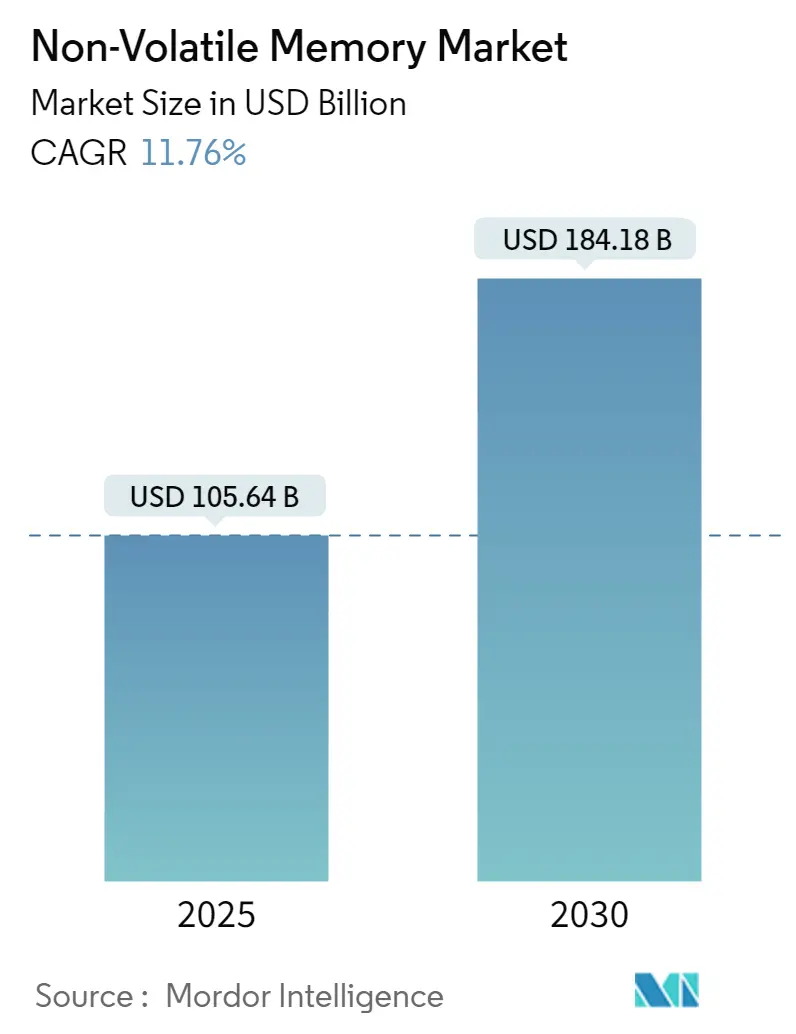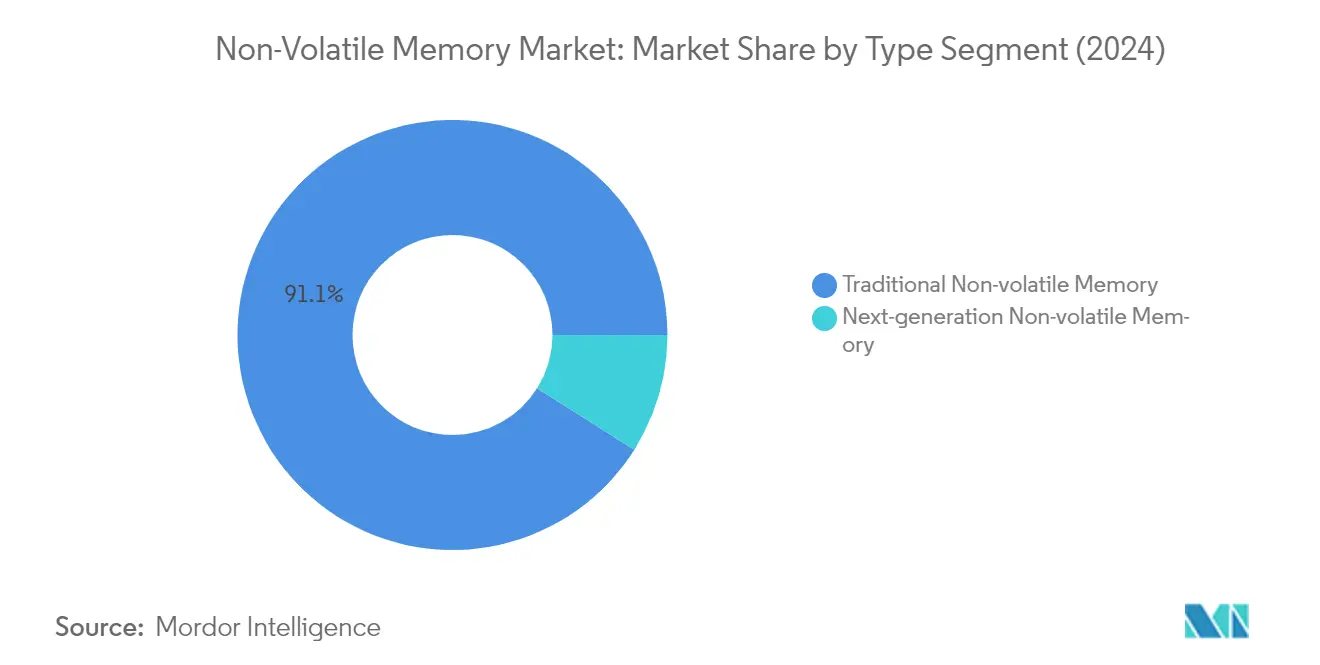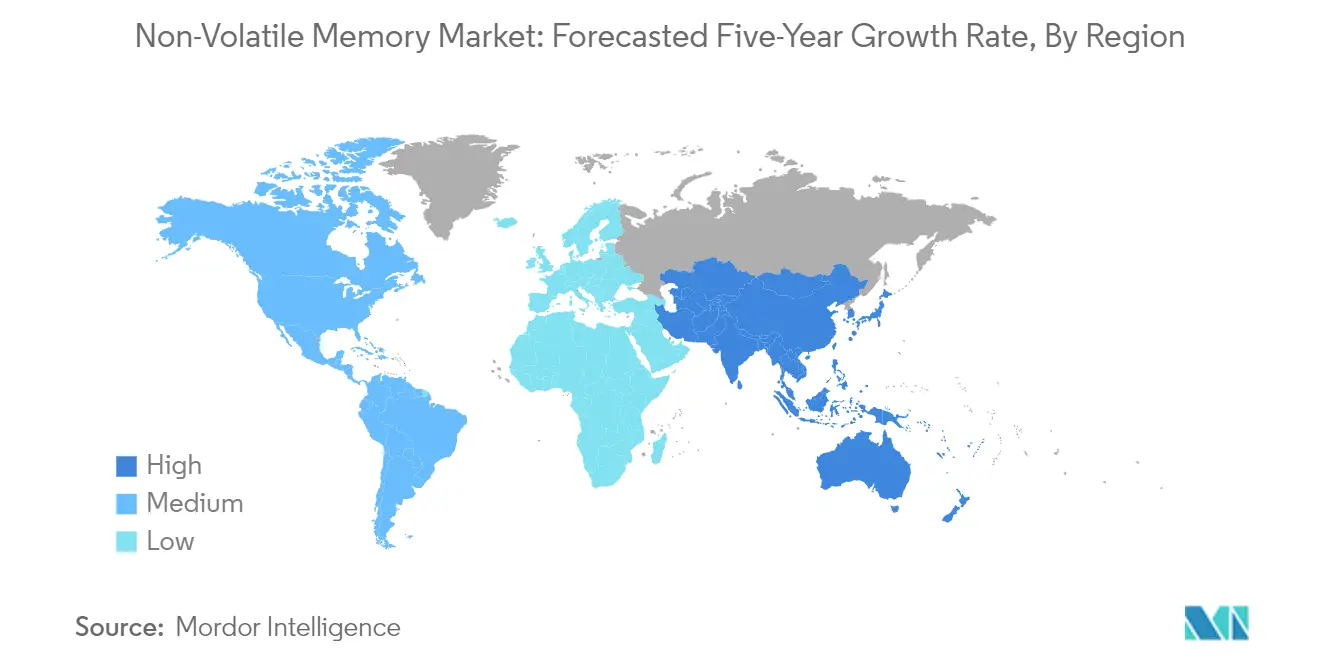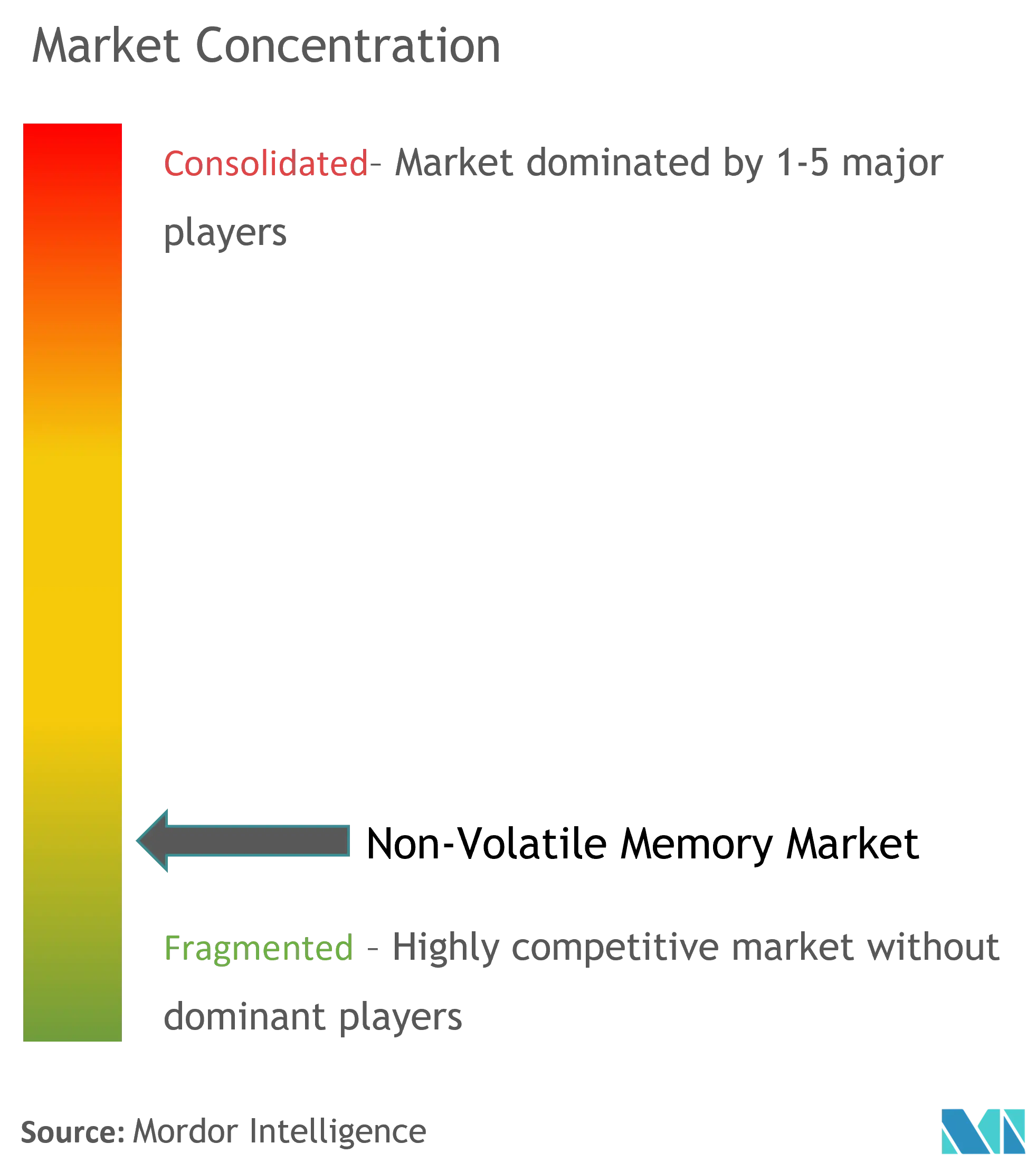Non-Volatile Memory Market Size and Share

Non-Volatile Memory Market Analysis by Mordor Intelligence
The Non-Volatile Memory Market size is estimated at USD 105.64 billion in 2025, and is expected to reach USD 184.18 billion by 2030, at a CAGR of 11.76% during the forecast period (2025-2030).
The non-volatile memory industry is experiencing transformative changes driven by technological advancements and evolving consumer demands. The rise of advanced computing applications has created unprecedented demands for memory devices that combine speed, efficiency, and reliability. According to Cisco's projections, approximately 500 billion devices are expected to be connected to the internet by 2030, highlighting the massive scale of future data storage requirements. The semiconductor industry has responded by developing innovative memory architectures, with significant breakthroughs in areas like UltraRAM, which combines the non-volatility of storage memory with the speed and endurance of working memory. This convergence of technologies is reshaping the landscape of semiconductor memory solutions across multiple industries.
The industry is witnessing substantial investments and strategic consolidations aimed at advancing memory technology capabilities. In 2023, Samsung made significant strides in developing MRAM technologies specifically designed for AI-powered applications, achieving 98% accuracy in handwritten digit identification and 93% in face detection through their innovative MRAM cell array designs. GlobalFoundries has committed $4 billion to expand its manufacturing footprint in Singapore, focusing on developing advanced semiconductor manufacturing facilities. These investments reflect the industry's commitment to pushing the boundaries of memory technology while addressing the growing demand for sophisticated memory storage solutions.
The evolution of memory technologies has led to the emergence of specialized solutions catering to different market segments. The development of ReRAM has opened new possibilities for memory applications, offering advantages such as lower power consumption and faster read-write speeds compared to traditional solutions. According to Cloudscene data, the United States alone hosts approximately 2,670 data centers, indicating the massive infrastructure supporting the digital economy and driving demand for advanced non-volatile memory solutions. The industry is actively working on optimizing these technologies for various applications, from edge computing to artificial intelligence.
The market is experiencing a significant shift toward more efficient and versatile memory solutions, particularly in emerging economies. According to GSMA forecasts, India is expected to contribute almost a quarter (24%) of the world's new mobile subscribers by 2025, indicating the massive potential for persistent memory technology adoption in developing markets. The industry is responding to these opportunities by developing more cost-effective and energy-efficient solutions. Major players are investing in research and development to create memory technologies that can support the next generation of electronic devices while addressing concerns about power consumption and performance reliability. This focus on innovation and efficiency is driving the development of new emerging memory architectures that promise to revolutionize how data is stored and accessed.
Global Non-Volatile Memory Market Trends and Insights
Growing Demand for Non-Volatile Memory in Connected and Wearable Devices
The proliferation of connected devices and wearable technology is creating unprecedented demand for non-volatile memory chips solutions that can deliver high performance in compact form factors. According to recent industry data, wearable user penetration has reached significant levels across major markets, with India leading at 0.38%, followed by China at 0.36%, and Sweden at 0.33%, highlighting the growing adoption of these devices. The integration of advanced features in wearables, including health monitoring, fitness tracking, and smart notifications, requires reliable and efficient embedded memory solutions that can operate with minimal power consumption while maintaining data integrity even when devices are powered off.
The explosive growth in Internet of Things (IoT) devices is further amplifying the need for sophisticated non-volatile digital memory solutions. Industry forecasts indicate that India alone will contribute approximately 24% of the world's new mobile subscribers by 2025, with 4G connections expected to exceed 75% penetration. This massive expansion in connected devices is driving demand for memory devices solutions that can support various applications, from smart home devices to industrial IoT implementations. Memory manufacturers are responding to these requirements by developing specialized solutions, as evidenced by Taiwan's United Microelectronics Corporation's introduction of embedded non-volatile STT-MRAM blocks based on a 28nm CMOS manufacturing process, specifically designed for IoT and wearable applications.
Increasing Demand for Enterprise Storage Applications
The enterprise data storage sector is experiencing substantial growth driven by the exponential increase in data generation and the need for high-performance computing solutions. Current data center storage capacity requirements are reaching unprecedented levels, with compute applications requiring 470 exabytes, collaboration platforms demanding 400 exabytes, and database/analytics applications necessitating 380 exabytes of storage. This massive scale of data management is compelling enterprises to adopt advanced non-volatile solid-state memory solutions that can deliver both speed and reliability while maintaining data integrity during power fluctuations.
The evolution of enterprise computing architectures and the growing adoption of cloud services are creating new demands for non-volatile computer memory solutions. With the United States alone hosting 2,670 data centers, followed by significant numbers in other major markets, the need for efficient data storage market solutions continues to grow. Enterprise storage requirements are becoming more sophisticated, particularly with the emergence of artificial intelligence and machine learning applications that demand high-speed, low-latency access to large datasets. In response to these needs, manufacturers are developing innovative solutions, as demonstrated by Western Digital's introduction of UFS 3.1 storage products designed to deliver high-end performance and capacity to support data-rich multimedia applications in enterprise environments.
Segment Analysis: By Type
Traditional Non-Volatile Memory Segment in Non-Volatile Memory Market
Traditional non-volatile memory dominates the global non-volatile memory market, commanding approximately 91% market share in 2024. This segment encompasses various memory technologies including flash memory, EEPROM, SRAM, and EPROM, with flash memory being the predominant technology. The segment's dominance is primarily driven by its widespread adoption in consumer electronics, particularly in smartphones, tablets, and laptops, where flash memory serves as the primary storage solution. The increasing demand for enterprise storage applications, data centers, and cloud computing infrastructure has further strengthened the position of traditional non-volatile memory technologies. Flash memory, in particular, has become indispensable in solid-state drives (SSDs) that are increasingly displacing hard disk drives as the primary storage device in desktops, laptops, and data centers.

Next-Generation Non-Volatile Memory Segment in Non-Volatile Memory Market
The next-generation non-volatile memory segment is experiencing rapid growth and transformation in the market, with technologies such as MRAM, FRAM, ReRAM, 3D XPoint, and Nano RAM leading the innovation frontier. This segment is projected to grow at approximately 21% CAGR from 2024 to 2029, driven by increasing demands for faster, more energy-efficient memory solutions. The growth is primarily fueled by emerging applications in artificial intelligence, Internet of Things (IoT) devices, and advanced computing systems that require high-performance, low-latency memory solutions. These next-generation technologies offer significant advantages over traditional memory solutions, including faster read/write speeds, lower power consumption, and higher endurance levels. The segment's growth is further supported by ongoing technological advancements and increasing investments in research and development by major semiconductor manufacturers.
Segment Analysis: By End-User Industry
IT and Telecom Segment in Non-Volatile Memory Market
The IT and Telecom sector dominates the non-volatile memory market, commanding approximately 43% market share in 2024. This significant market position is driven by the increasing adoption of enterprise storage technologies and the growing size of data centers worldwide. The segment's leadership is further strengthened by the rising demand for advanced storage solutions to handle the massive storage requirements of organizations. With the proliferation of 5G technology and cloud computing, telecom companies are increasingly adopting high-end memory technologies to provide cost-effective and faster memory solutions compared to traditional technologies. The integration of artificial intelligence and IoT applications in the IT sector has also fueled the demand for more efficient and reliable non-volatile memory solutions.
Consumer Electronics Segment in Non-Volatile Memory Market
The consumer electronics segment is projected to exhibit the fastest growth in the non-volatile memory market from 2024 to 2029, with an expected growth rate of approximately 11%. This accelerated growth is primarily driven by the increasing integration of non-volatile memory in smartphones, tablets, wearable devices, and other consumer electronic products. The segment's expansion is further supported by the rising demand for high-density storage solutions in portable devices and the growing adoption of IoT-enabled consumer devices. The development of advanced memory technologies like NRAM and other high-performance solutions is enabling consumer electronics manufacturers to create more sophisticated and efficient devices with enhanced storage capabilities and improved power consumption characteristics.
Remaining Segments in End-User Industry
The retail, healthcare, and other end-user industries represent significant opportunities in the non-volatile memory market, albeit with smaller market shares. The retail sector is witnessing increased adoption of non-volatile memory solutions in point-of-sale systems, inventory management, and other retail operations. The healthcare sector is experiencing growing demand for reliable storage solutions in medical devices and equipment, particularly in diagnostic and monitoring devices. Other industries, including automotive and industrial sectors, are also incorporating non-volatile memory solutions for various applications, from vehicle control systems to industrial automation equipment, contributing to the overall market diversity and growth.
Non-Volatile Memory Market Geography Segment Analysis
Non-Volatile Memory Market in North America
North America represents one of the most technologically advanced markets for the non-volatile memory sector solutions, driven by the presence of major technology companies, extensive data center infrastructure, and early adoption of emerging technologies. The United States and Canada form the key markets in this region, with both countries showing strong momentum in adopting next-generation memory technologies across various sectors, including consumer electronics, automotive, and enterprise storage. The region's growth is particularly fueled by increasing investments in cloud computing infrastructure, the expansion of 5G networks, and rising demand for IoT devices in the memory semiconductor industry.

Non-Volatile Memory Market in United States
The United States dominates the North American non-volatile memory market, holding approximately 29% of the global market share in 2024. The country's market leadership is attributed to its robust semiconductor memory industry, extensive research and development activities, and the presence of major technology companies. The United States has witnessed significant adoption of the memory chip sector solutions across various sectors, particularly in data centers, where companies are increasingly focusing on high-performance computing and artificial intelligence applications. The country's strong position is further reinforced by the presence of numerous data centers, with over 2,670 facilities across various states, making it the largest data center market globally.
Non-Volatile Memory Market in Canada
Canada emerges as the fastest-growing market in the North American region, with a projected growth rate of approximately 10% during 2024-2029. The country's market is experiencing rapid expansion due to increasing investments in digital infrastructure and growing adoption of cloud computing services. Canada's strategic focus on emerging technologies, including artificial intelligence and IoT applications, is driving the demand for advanced semiconductor memory solutions. The country has also witnessed significant growth in its data center infrastructure, with approximately 269 data center facilities, supporting the increasing demand for non-volatile memory solutions across various industries.
Non-Volatile Memory Market in Europe
The European non-volatile memory market demonstrates strong growth potential, supported by increasing digitalization initiatives across various industries and substantial investments in emerging technologies. The region's market is primarily driven by countries such as Germany, the United Kingdom, and France, each contributing significantly to the overall market growth. The European market benefits from strong research and development activities in next-generation memory technologies, particularly in areas such as automotive electronics, industrial automation, and IoT applications.
Non-Volatile Memory Market in Germany
Germany stands as the largest market for non-volatile memory solutions in Europe, commanding approximately 33% of the regional market share in 2024. The country's market leadership is driven by its robust automotive sector, strong industrial base, and significant investments in Industry 4.0 initiatives. Germany's position is further strengthened by its extensive data center infrastructure, with over 111 data centers supporting various industries. The country's focus on technological innovation and digital transformation continues to drive the adoption of advanced memory chip industry solutions across various sectors.
Non-Volatile Memory Market in United Kingdom
The United Kingdom emerges as the fastest-growing market in the European region, with a projected growth rate of approximately 10% during 2024-2029. The country's market growth is driven by increasing investments in digital infrastructure, rising adoption of cloud services, and growing demand for advanced data storage solutions in various applications. The UK's strong focus on financial technology, artificial intelligence, and IoT applications continues to drive the demand for non-volatile memory solutions. The country's strategic initiatives in developing next-generation memory technologies and supporting infrastructure contribute to its rapid market growth.
Non-Volatile Memory Market in Asia-Pacific
The Asia-Pacific region represents a crucial market for non-volatile memory solutions, characterized by rapid technological adoption and significant manufacturing capabilities. Countries such as China, Japan, South Korea, and India play pivotal roles in shaping the regional market landscape. The region benefits from the presence of major semiconductor manufacturers, extensive electronics manufacturing facilities, and growing investments in digital infrastructure. The market is particularly driven by increasing smartphone penetration, expanding data center capacities, and rising adoption of IoT devices across various industries in the memory chip sector.
Non-Volatile Memory Market in China
China dominates the Asia-Pacific non-volatile memory market, establishing itself as both the largest and fastest-growing market in the region. The country's market leadership is attributed to its extensive electronics manufacturing ecosystem, substantial investments in semiconductor technology, and rapid digital transformation across various sectors. China's strong position is supported by its robust supply chain infrastructure, growing domestic demand for electronic devices, and significant investments in emerging technologies such as 5G, artificial intelligence, and IoT applications.
Non-Volatile Memory Market in Japan
Japan maintains a significant position in the Asia-Pacific non-volatile memory market, driven by its advanced technological capabilities and strong presence in the semiconductor industry. The country's market is characterized by substantial research and development activities in next-generation memory technologies, particularly in automotive and industrial applications. Japan's focus on developing innovative memory solutions, coupled with its strong manufacturing capabilities, continues to drive market growth and technological advancement in the region.
Non-Volatile Memory Market in Latin America
The Latin American non-volatile memory market demonstrates growing potential, driven by increasing digital transformation initiatives and rising adoption of cloud computing services across various industries. The region is witnessing significant investments in data center infrastructure, particularly in countries like Brazil and Mexico, which emerge as the largest and fastest-growing markets respectively. The market growth is further supported by the expanding e-commerce sector, increasing smartphone penetration, and growing demand for advanced data storage solutions in various applications. The region's transition towards digital technologies and the implementation of 5G networks are creating new opportunities for flash memory solutions across different sectors.
Non-Volatile Memory Market in Middle East & Africa
The Middle East & Africa region presents emerging opportunities in the non-volatile memory market, driven by increasing investments in digital infrastructure and growing adoption of advanced technologies. The United Arab Emirates and South Africa emerge as the largest and fastest-growing markets respectively, supported by significant investments in smart city initiatives and digital transformation projects. The region's market growth is particularly influenced by the expanding data center infrastructure, increasing cloud adoption, and growing demand for advanced flash memory solutions across various sectors. The implementation of digital transformation initiatives by governments and enterprises continues to drive the adoption of NVM solutions throughout the region.
Competitive Landscape
Top Companies in Non-Volatile Memory Market
The non-volatile memory market is characterized by intense innovation and strategic developments from key players, including Intel Corporation, Samsung Electronics, Micron Technology, Fujitsu, and Honeywell International. Companies are focusing on developing next-generation memory chips technologies like 3D XPoint, MRAM, and ReRAM to address growing demands for higher performance and energy efficiency. Major players are expanding their manufacturing capabilities through significant investments in new fabrication facilities and advanced production technologies like EUV lithography. Strategic partnerships and collaborations are being formed to accelerate technology development and market penetration, particularly in emerging areas like IoT, AI, and automotive applications. The industry is witnessing an increased focus on research and development to create differentiated products with improved density, speed, and power consumption characteristics, while companies are also pursuing vertical integration to strengthen their market positions.
Consolidated Market with Strong Global Players
The non-volatile memory market structure is dominated by large multinational corporations with extensive manufacturing capabilities and robust research and development infrastructure. These companies typically operate across multiple segments of the semiconductor memory industry, leveraging their technological expertise and established customer relationships to maintain market leadership. The market shows significant consolidation through strategic acquisitions and mergers, as evidenced by deals like SK Hynix's acquisition of Intel's NAND business and Analog Devices' acquisition of Maxim Integrated, which aim to achieve economies of scale and expand technology portfolios.
The competitive landscape is further shaped by the presence of specialized players focusing on specific memory device technologies or market segments, particularly in emerging areas like MRAM and ReRAM. Market entry barriers are substantial due to high capital requirements, complex manufacturing processes, and the need for extensive intellectual property portfolios. Regional dynamics play a crucial role, with companies establishing strategic manufacturing bases in key markets like Asia-Pacific to maintain cost competitiveness and ensure proximity to major customers in the electronics manufacturing ecosystem.
Innovation and Adaptability Drive Market Success
Success in the non-volatile memory market increasingly depends on companies' ability to innovate and adapt to rapidly evolving technology requirements. Incumbent players must maintain technological leadership through continuous investment in research and development, while also optimizing their manufacturing processes to improve cost efficiency and yield rates. Strategic partnerships with end-users in key growth segments like automotive, IoT, and data centers are becoming crucial for product development and market expansion. Companies need to develop comprehensive product portfolios that address diverse application requirements while maintaining flexibility to respond to changing market demands.
For new entrants and smaller players, success lies in identifying and focusing on specific market niches where they can develop differentiated solutions. This includes developing specialized memory storage solutions for emerging applications or addressing specific performance requirements not met by mainstream products. Building strong intellectual property positions and forming strategic alliances with larger players or key customers can help overcome market entry barriers. The increasing focus on data security and reliability, particularly in automotive and industrial applications, creates opportunities for companies that can develop robust solutions meeting stringent regulatory requirements and reliability standards.
Non-Volatile Memory Industry Leaders
-
Rohm co. ltd
-
STMicroelectronics NV
-
Fujitsu ltd
-
Intel Corporation
-
Honeywell International Inc.
- *Disclaimer: Major Players sorted in no particular order

Recent Industry Developments
- May 2022 - Toshiba Electronic Devices & Storage Corporation and Japan Semiconductor Corporation together developed an analog platform with an embedded non-volatile memory (eNVM) for automotive applications. According to the company, the 0.13-micron generation analog platform, applied to analog integrated circuits (ICs), offers an optimized combination of processes and devices, according to rated voltage, performance, reliability, and cost, for automotive analog circuits and eNVM on a single chip.
- April 2022 - Researchers from the Korean Advanced Institute of Science and Technology (KAIST) announced the development of a new computer system that uses non-volatile memory as its main program memory. According to the company, the new design, called LightPC, allows for powering up and down during mid-execution without experiencing data loss. Additionally, using non-volatile memory allowed for up to 8 times more memory.
Global Non-Volatile Memory Market Report Scope
Non-volatile memory is a computer memory that can retain information stored on it even when turned off. Types of memories, such as flash memory, SRAM, EPROM, and EEPROM, are considered under the traditional non-volatile memory. In contrast, MRAM, FRAM, ReRAM, 3D-X point, and nano RAM are considered under next-generation non-volatile memories. The end-user industries considered part of the study include IT and telecom, retail, healthcare, consumer electronics, and other sectors in various geographies. Also, the study also includes the impact of COVID-19 on the market.
| Traditional Non-volatile Memory | Flash Memory |
| EEPROM | |
| SRAM | |
| EPROM | |
| Other Traditional Non-volatile Memories | |
| Next-generation Non-volatile Memory | MRAM |
| FRAM | |
| ReRAM | |
| 3D-X Point | |
| Nano RAM | |
| Other Next-generation Non-volatile Memories |
| Consumer Electronics |
| Retail |
| IT and Telecom |
| Healthcare |
| Other End-user Industries |
| North America | United States |
| Canada | |
| Europe | United Kingdom |
| Germany | |
| France | |
| Rest of Europe | |
| Asia Pacific | China |
| Japan | |
| South Korea | |
| India | |
| Rest of Asia Pacific | |
| Latin America | |
| Middle East and Africa |
| By Type | Traditional Non-volatile Memory | Flash Memory |
| EEPROM | ||
| SRAM | ||
| EPROM | ||
| Other Traditional Non-volatile Memories | ||
| Next-generation Non-volatile Memory | MRAM | |
| FRAM | ||
| ReRAM | ||
| 3D-X Point | ||
| Nano RAM | ||
| Other Next-generation Non-volatile Memories | ||
| By End-user Industry | Consumer Electronics | |
| Retail | ||
| IT and Telecom | ||
| Healthcare | ||
| Other End-user Industries | ||
| By Geography | North America | United States |
| Canada | ||
| Europe | United Kingdom | |
| Germany | ||
| France | ||
| Rest of Europe | ||
| Asia Pacific | China | |
| Japan | ||
| South Korea | ||
| India | ||
| Rest of Asia Pacific | ||
| Latin America | ||
| Middle East and Africa | ||
Key Questions Answered in the Report
How big is the Non-Volatile Memory Market?
The Non-Volatile Memory Market size is expected to reach USD 105.64 billion in 2025 and grow at a CAGR of 11.76% to reach USD 184.18 billion by 2030.
What is the current Non-Volatile Memory Market size?
In 2025, the Non-Volatile Memory Market size is expected to reach USD 105.64 billion.
Who are the key players in Non-Volatile Memory Market?
Rohm co. ltd, STMicroelectronics NV, Fujitsu ltd, Intel Corporation and Honeywell International Inc. are the major companies operating in the Non-Volatile Memory Market.
Which is the fastest growing region in Non-Volatile Memory Market?
Asia Pacific is estimated to grow at the highest CAGR over the forecast period (2025-2030).
Which region has the biggest share in Non-Volatile Memory Market?
In 2025, the Asia Pacific accounts for the largest market share in Non-Volatile Memory Market.
What years does this Non-Volatile Memory Market cover, and what was the market size in 2024?
In 2024, the Non-Volatile Memory Market size was estimated at USD 93.22 billion. The report covers the Non-Volatile Memory Market historical market size for years: 2019, 2020, 2021, 2022, 2023 and 2024. The report also forecasts the Non-Volatile Memory Market size for years: 2025, 2026, 2027, 2028, 2029 and 2030.
Page last updated on:
.webp)


